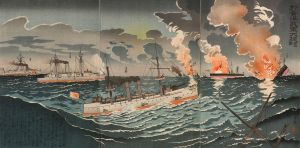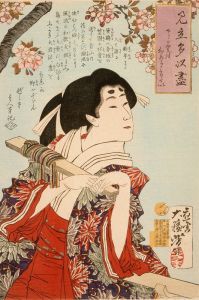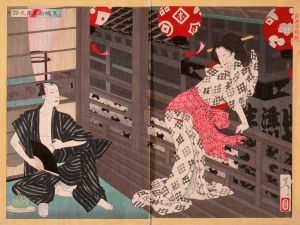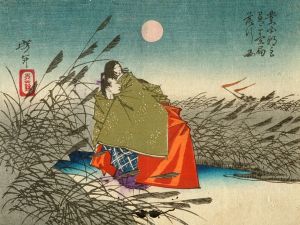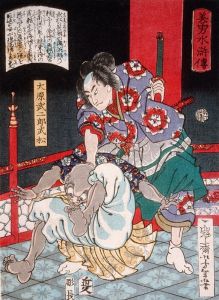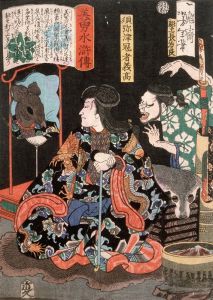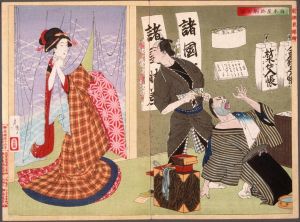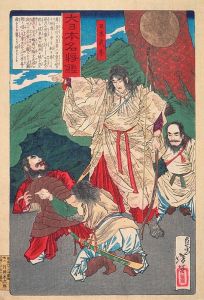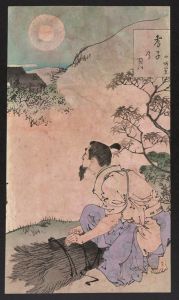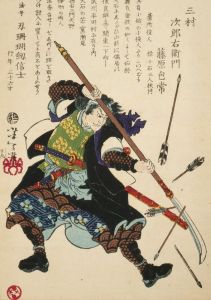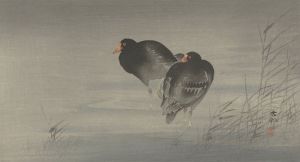
Muraoka of the Konoe Clan Bound with Rope
A hand-painted replica of Tsukioka Yoshitoshi’s masterpiece Muraoka of the Konoe Clan Bound with Rope, meticulously crafted by professional artists to capture the true essence of the original. Each piece is created with museum-quality canvas and rare mineral pigments, carefully painted by experienced artists with delicate brushstrokes and rich, layered colors to perfectly recreate the texture of the original artwork. Unlike machine-printed reproductions, this hand-painted version brings the painting to life, infused with the artist’s emotions and skill in every stroke. Whether for personal collection or home decoration, it instantly elevates the artistic atmosphere of any space.
Tsukioka Yoshitoshi (1839–1892) was a renowned Japanese artist known for his woodblock prints and paintings, particularly in the ukiyo-e style. He is often celebrated for his innovative approach to traditional Japanese art and his ability to capture the complexities of human emotion and historical narratives. One of his notable works is "Muraoka of the Konoe Clan Bound with Rope," which is part of his larger series of prints.
"Muraoka of the Konoe Clan Bound with Rope" is a woodblock print that exemplifies Yoshitoshi's skill in depicting dramatic and poignant scenes. This artwork is part of his series "New Forms of Thirty-Six Ghosts" (Shinkei Sanjūrokkaisen), which was published between 1889 and 1892. The series is known for its exploration of supernatural themes, historical events, and legendary figures from Japanese folklore and history.
The print depicts Muraoka, a character associated with the Konoe clan, a prominent noble family in Japan. The Konoe clan was one of the five regent houses (go-sekke) that provided regents to the Japanese imperial court. The specific historical or legendary context of Muraoka's story is not widely documented, but the image of her bound with rope suggests a scene of capture or punishment, which is a common motif in Yoshitoshi's work, reflecting themes of struggle and resilience.
Yoshitoshi's work is characterized by its vivid use of color, intricate details, and expressive figures. In "Muraoka of the Konoe Clan Bound with Rope," these elements come together to create a powerful image that evokes a sense of tension and drama. The use of light and shadow, along with the careful attention to the character's expression and posture, highlights Yoshitoshi's mastery in conveying emotion and narrative through visual art.
The "New Forms of Thirty-Six Ghosts" series, including the print of Muraoka, is significant in Yoshitoshi's oeuvre as it represents a period in his career where he was deeply engaged with themes of the supernatural and the macabre. This series is often seen as a reflection of Yoshitoshi's own struggles with mental health and the turbulent times he lived in, as Japan was undergoing rapid modernization during the Meiji era.
Yoshitoshi's work, including "Muraoka of the Konoe Clan Bound with Rope," has been influential in both Japanese and Western art circles. His ability to blend traditional Japanese artistic techniques with innovative storytelling has earned him a lasting legacy as one of the last great masters of ukiyo-e. His prints continue to be studied and admired for their artistic merit and their insight into the cultural and historical context of 19th-century Japan.
Overall, "Muraoka of the Konoe Clan Bound with Rope" is a testament to Yoshitoshi's artistic vision and his ability to capture complex narratives within a single image. The print remains an important piece within the study of Japanese art and serves as an example of the enduring power of visual storytelling.





